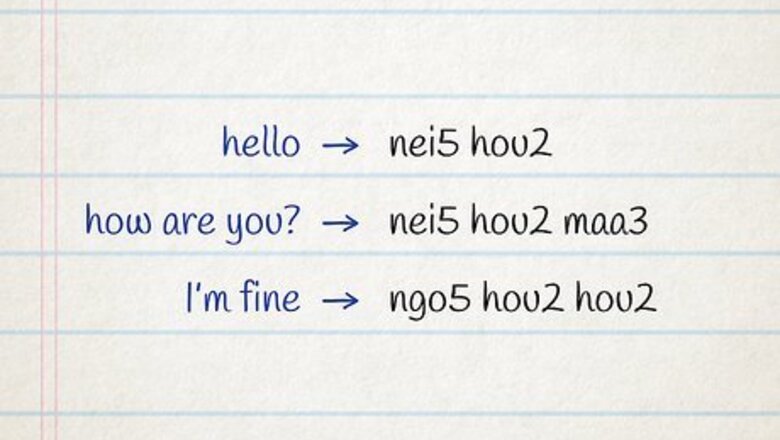
views
X
Research source
Cantonese has a reputation as a difficult language to learn, especially if you're not familiar with tonal languages. But if you focus on pronunciation and learn a little every day, you'll get the hang of it! Start with common words and phrases that will allow you to have a basic conversation. Talking to native speakers is the best way to learn Cantonese. Written Cantonese, which uses Chinese characters, is even more difficult to learn. The easiest way to get started speaking is with jyutping, which uses the Latin alphabet and numbers to indicate the tone of each syllable.[2]
X
Research source
Greetings and Small Talk

Say "hello" with "nei5 hou2." This is the basic way to greet people in Cantonese and is appropriate in any setting when greeting anyone, regardless of their age or position. Follow up with "nei5 hou2 maa3" to ask the person "How are you?" Respond to "nei5 hou2 maa3" with "ngo5 hou2 hou2," which is similar to saying "I'm fine" in English. If the other person asks you first, you might add "nei5 ne1," which means "how about you" or "and you." When greeting friends or children, you can also say "hei1." This is a more casual greeting that's usually not suitable if you're greeting a stranger or someone older than you. In Hong Kong, you might also use "haa1 lo3" as a casual greeting.
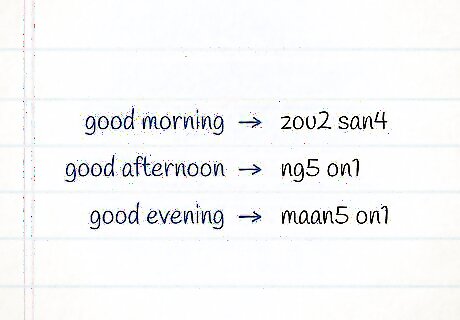
Change your greetings depending on the time of the day. Like other languages, Cantonese also has greetings that are specific to morning, afternoon, and evening. As with "nei5 hou2," these greetings are appropriate in any social setting. Here are some you can try: "Zou2 san4": good morning "Ng5 on1": good afternoon "Maan5 on1": good evening
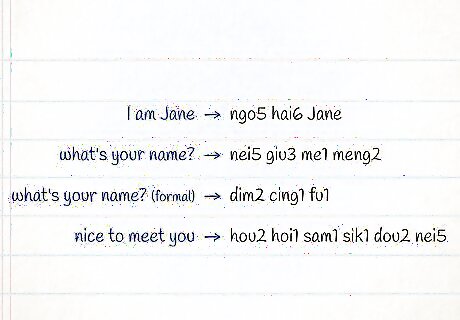
Use "ngo5 hai6" followed by your name to introduce yourself. This phrase allows you to tell the person you're name. Don't worry about making your name sound Chinese. Just say your name as you would normally pronounce it in your native language. You might follow with "nei5 giu3 me1 meng2," which means "what's your name?" If you're talking to someone who's older or in a position of authority and want to ask their name, use the more formal "dim2 cing1 fu1." When someone introduces themselves to you, respond with "hou2 hoi1 sam1 sik1 dou2 nei5," which means "nice to meet you." Since this phrase means "I am," you can use it to tell people your occupation, your nationality, or really anything that you "are."

Ask questions to keep the conversation going. One of the easiest ways to get to know someone in any language is to ask them questions about themselves. It's okay if you don't understand their answers completely! This is a good way to learn more of the language. Here are some questions to ask: "Nei5 hai6 bin1 dou6 lai4?": Where are you from? "Nei5 zyu6 hai6 bin1 dou6?": Where do you live? "Ni1 dou6 zung1 ji3 m4 zong1 ji3?": Do you like it here? "Nei5 mat1 je5 zou6 zik1 jip6?": What do you do for a living? "Nei5 gei2 seoi3 aa3?": How old are you?
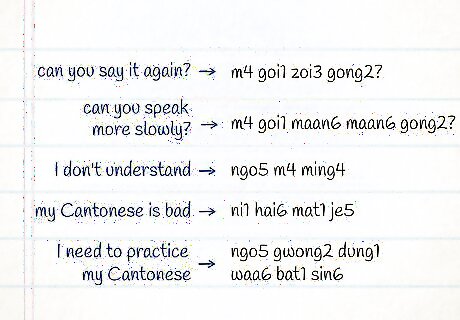
Explain that you're in the process of learning Cantonese. When you first start speaking to a native speaker, you want to let them know pretty early on in the conversation that you aren't fluent in Cantonese. This way, they'll be more willing to help you if you make a mistake. Some phrases to learn include: "M4 goi1 zoi3 gong2?": Can you say it again? "M4 goi1 maan6 maan6 gong2?" Can you speak more slowly? "Ngo5 m4 ming4": I don't understand "Ni1 hai6 mat1 je5": My Cantonese is bad "Ngo5 gwong2 dung1 waa6 bat1 sin6": I need to practice my Cantonese

End a conversation by saying "zoi3 gin3." This phrase means "goodbye," and is a suitable way to end a conversation when you're heading off on your way. In casual settings in Hong Kong, you might also say "baai1 baai3." If you're leaving for the night or going to bed, you might also say "zou2 tau2," which means "good night."
Important Words and Phrases
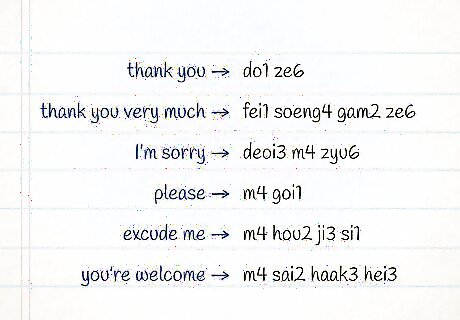
Mind your manners with polite words and phrases. Being polite shows respect and honor to the person you're talking to. Even if your Cantonese isn't very good, people will be more accepting and willing to help you if you use the following words and phrases: "Do1 ze6": thank you (specifically when someone gives you a gift) "Fei1 soeng4 gam2 ze6" or "do1 ze6 saai3": thank you very much "Deoi3 m4 zyu6": I'm sorry "M4 goi1": please (also used as "thank you" for a service rendered) "M4 hou2 ji3 si1": excuse me. You can also use "m4 goi1" for "excuse me," such as when someone is blocking your path. "M4 sai2 haak3 hei3": you're welcome (response to "thank you")

Count from 1 to 10 in Cantonese. Counting is a basic skill you typically learn early on in any language. While you don't necessarily need to know all the numbers to get around in a Cantonese-speaking area, you should at least know how to count to 10: 1: jat1 (一) 2: ji6 (二) 3: saam1 (三) 4: sei3 (四) 5: ng5 (五) 6: luk6 (六) 7: cat1 (七) 8: baat3 (八) 9: gau2 (九) 10: sap6 (十)
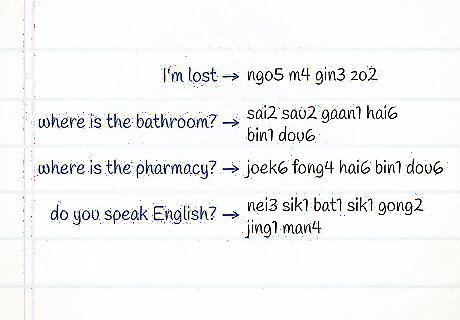
Use "nei5 ho2 m4 ho2 ji5 bong1 zo6 ngo5" to ask someone for help. This question means "can you help me," and will come in handy if you're visiting in a Cantonese-speaking area. While this question will get attention, you might not be able to find someone who speaks English or your native language this way, so it's good to know a few follow-up comments as well: "Ngo5 m4 gin3 zo2": I'm lost "Sai2 sau2 gaan1 hai6 bin1 dou6": Where is the bathroom? "Joek6 fong4 hai6 bin1 dou6": Where is the pharmacy? "Nei3 sik1 bat1 sik1 gong2 jing1 man4": Do you speak English?
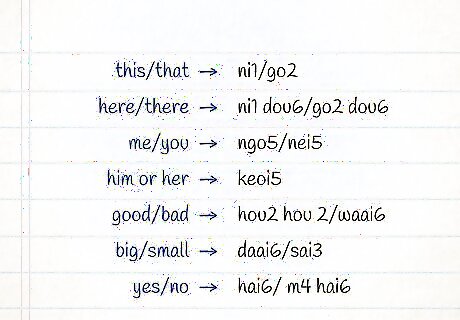
Pick up a few extra words so you understand more from context. Even if you only know a few words here and there, it can still help you understand what someone is saying. After a while, particularly if you're immersing yourself in the language, you'll be able to understand more and more. Here are some important words to learn: "Ni1/go2": this/that "Ni1 dou6/go2 dou6": here/there "Ngo5/nei5": me/you "Keoi5": him or her "Hou2 hou 2/waai6": good/bad "Daai6/sai3": big/small "Hai6/ m4 hai6": yes/no
Basic Pronunciation
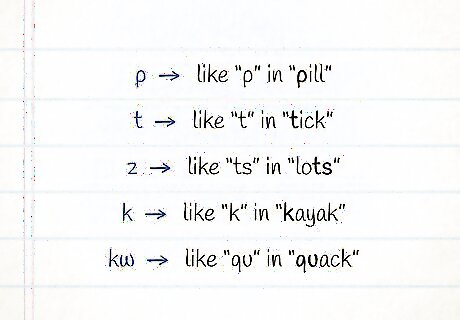
Exhale a puff of air to say aspirated consonant sounds. Cantonese has 5 aspirated consonant sounds, which you pronounce with a heavy puff of air. Practice with a mirror close to your mouth so you can tell if you're aspirating: The "p" sound is similar to the "p" in the English word "pill." The "t" sound is similar to the "t" in the English word "tick." The "z" sound is similar to the "ts" in the English word "lots" or the German word "tschüss." The "k" sound is similar to the "k" in the English word "kayak." The "kw" sound is similar to the "qu" in the English word "quack."
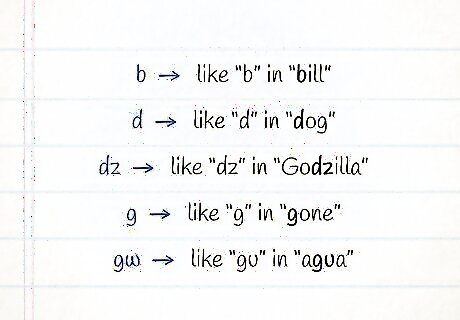
Work on unaspirated consonant sounds. To pronounce the next 5 consonant sounds in Cantonese, you don't exhale a puff of air. This can take some practice since some of these consonants are often aspirated in English. Here are the 5 unaspirated consonant sounds: The "b" sound is similar to the "b" in the English word "bill." The "d" sound is similar to the "d" in the English word "dog." The "dz" sound is similar to the "dz" in the name "Godzilla." This sound can occur at the beginning of Cantonese words, unlike in English. The "g" sound is similar to the "g" in the English word "gone." The "gw" sound is similar to the "gu" in the Spanish word "agua."

Add other consonant sounds that are similar to English. Of the 20 total consonant sounds in the Cantonese language, 10 of them are pronounced similarly to their English counterparts. If you already speak English, you'll find these sounds easy to master: The "f" sound is similar to the "f" in the English word "fall." The "h" sound is similar to the "h" in the English word "hit." The "l" sound is similar to the "l" in the English word "lick." The "m" sound is similar to the "m" in the English word "mother." The "n" sound is similar to the "n" in the English word "noon." The "ng" sound is similar to the "ng" in the English word "long." However, unlike English, this sound also appears at the beginning of words. The "s" sound is similar to the "s" in the English word "see." The "y" sound is similar to the "y" in the English word "yet." The "w" sound is similar to the "w" in the English word "wet." The "z" sound is similar to the

Make 7 vowel sounds. In addition to consonant sounds, Cantonese also has 7 individual vowel sounds. These sounds are represented in jyutping as follows: The "aa" sound is similar to the "a" in the English word "far." The "e" sound is similar to the "e" in the English word "yes." The "i" sound is similar to the "i" in the English word "ski." The "o" sound is similar to the "o" in the English word "ore." The "u" sound is similar to the "oo" in the English word "food." The "oe" sound is similar to the "u" in the English word "fur" or the "eu" in the French word "fleuve." The "yu" sound is similar to the "u" in the English word "menu."
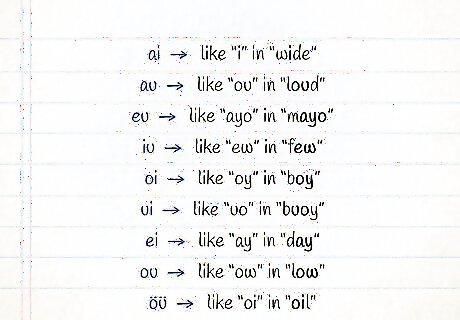
Combine vowel sounds to make diphthongs. When 2 vowels appear next to each other in a Cantonese syllable, slide their sounds together to create a new sound. Most of these sounds are also common in English, although you might not associate them with the alphabet letters that represent them in jyutping: The "ai" sound is similar to the "i" in the English word "wide." The "au" sound is similar to the "ou" in the English word "loud." The "eu" sound is similar to the "ayo" in the English word "mayo." The "iu" sound is similar to the "ew" in the English word "few." The "oi" sound is similar to the "oy" in the English word "boy" or the "äu" in the German word "Häuser." The "ui" sound is similar to the "uo" in the English word "buoy." The "ei" sound is similar to the "ay" in the English word "day." The "ou" sound is similar to the "ow" in the English word "low." The "öü" sound is similar to the "oi" in the English word "oil" or the diphthong in the French word "œil."

Practice the 6 Cantonese tones. Cantonese is a tonal language, meaning the high, low, rising, or falling tone of your voice affects the meaning of the syllable or word you pronounce. In Cantonese jyutping, each syllable is followed by a number from 1 to 6 that tells you which tone to say the syllable in. It can take some practice to get this right, especially if you don't have experience with tonal languages. 1 is a high tone. Your voice stays level on the same tone throughout. Think of how your voice would rise in pitch when you ask a question — the final tone is your high tone. 2 is a rising tone that starts in the low-mid range and ends high. Think of how your voice would start low and rise in pitch if you were wondering what someone was doing. 3 is a middle tone. 4 is a falling tone that starts in the low-mid range and drops to the low range. 5 is a rising tone that starts low and goes up to low-mid. 6 is a low-mid tone that stays level throughout.

Clip the consonant sound with syllables ending in "p," "t," or "k." A syllable ending in one of these 3 sounds is pronounced more quickly, with a shorter vowel. The result is that the syllable sounds clipped, as though you suddenly cut your breath in the middle of the closing consonant sound. Listen to native speakers to better understand how this sounds. These syllables are accompanied by their own tones, also referred to as the 7th, 8th, and 9th tones. The 7th is similar to the 1st tone, the 8th corresponds to the 3rd tone, and the 9th shares the same pitch as the 6th tone.



















Comments
0 comment